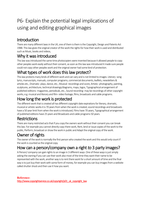P6- Explain the potential legal implications of
using and editing graphical images
Introduction
There are many different laws in the UK, one of them is them is the Copyright, Design and Patents Act
1988. This law gives the original creator of the work the rights for how their work is used and distributed
such as Music, books and videos,
Why it was introduced
This law was introduced the same time photocopiers were invented because it allowed people to copy
other peoples work easily without their consent, as soon as this law was introduced it made sure people
could not copy other peoples work and the original owner had some kind of protection.
What types of work does this law protect?
This law protects many kinds of different work and can vary and is not limited to images. Literary song
lyrics, manuscripts, manuals, computer programs, commercial documents, leaflets, newsletters &
articles etc., Dramatic- plays, dance, etc., Musical- recordings and score, Artistic- photography, painting,
sculptures, architecture, technical drawings/diagrams, maps, logos, Typographical arrangement of
published editions- magazines, periodicals, etc., Sound recording- may be recordings of other copyright
works, e.g. musical and literary and film- video footage, films, broadcasts and cable programs.
How long the work is protected
The different work that is created all has different copyright date expirations for literary, dramatic,
musical or artistic works it is 70 years from when the work is created, sound recordings and broadcasts
have a 50 year limit from when the work is introduced, Films have 70 years, Typographical arrangement
of published editions have 25 years and Broadcasts and cable programs 50 years.
Restrictions
There are many restricted acts that if you copy the owners work without their consent you can break
this law. For example you cannot directly copy there work, Rent, lend or issue copies of the work to the
public, Perform, broadcast or show the work in public and Adapt the original copy of the work.
Owner of rights
The owner of the work is normally the first person who created the work and this would only count if
the work is counted as the original copy.
How can a person/company own a right to 3 party images?
A Person/ company can gain rights to an image in 3 different ways. One of these ways is just simply
asking the owning if you can use their work also most of the time they want their name to be
represented with the work, another way is to rent there work for a short amount of time and the final
way is to just buy their work with some form of money, for example you can buy images from a website
called shutter shock and then use it how you want.
Reference:
http://www.copyrightservice.co.uk/copyright/p01_uk_copyright_law




